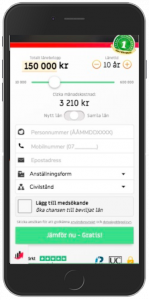
The humble registration form. So difficult to get right but oh so easy to get wrong.
A couple of weeks ago our brilliant CRO Specialist Lukas Rogvall presented a webinar on one of our customers, Sambla. Sambla are loan intermediaries based in Stockholm, Sweden that, since 2014, have helped over 390 000 customers compare their loans. Before Symplify started working with Sambla they had no in-house team for CRO. Today, Sambla have expanded their experimental culture and now has a lean CRO team which working towards the goal of having a maximum downtime* of 5% with their A/B testing.
*Time spent without running tests.
Now, before we started A/B testing on the website we had to put in some ground work. We started by doing a conversion analysis, we used analytical tools and let our experts go through Sambla’s website. Based on this research it was established that a crucial part of the customer journey was the registration form. It is where the entire customer journey begins and is therefore a page with high revenue and it is of utmost importance that we make sure the form is optimized.
We have all encountered registration forms and the classic problems associated with them. They are either too long, have too many fields to fill in or are simply just overwhelming. Search online and you’ll find numerous “how to’s” and lists on how to improve your registration form. But we don’t want to implement “one size fits all” thinking on our website that could lead to even more uncertainty in terms of conversion improvement. And this is why we A/B test.
One of the A/B tests that we executed on the form was based on “The foot in the door” technique . What this means is that if you start by making a small request and the user completes this, it will be easier to then have the user complete the bigger request. Knowing this we hypothesized that we could get more users to complete the entire form if we started by only asking the user to complete a smaller task initially.
Below you can see the original execution at Sambla for their registration form. There are several fields where you need to fill quite sensitive information, meaning that the threshold to completion is generally higher.

What we then tested was an execution where we just folded in the part of the form where you started filling in your information. So you will first be met by the easier part of the form where you just have to adjust the loan information and then you can continue to the part of the form where you have to start filling in your personal information.

So the hypothesis was that once you’ve completed the simpler task of filling in the information on the loan, you would then be more inclined to finish the rest of the form where you enter your personal information which can be a more overwhelming task.
However, the result showed that the variant did not outperform the original. So where do we go from there? Well just because you don’t see the uplift right now, doesn’t necessarily mean that your hypothesis is wrong. So after this A/B test had run its course we started thinking that maybe the execution and adaptation of the hypothesis was wrong. Because we know that it’s a solid hypothesis but did we implement it in the right way? Turns out, we didn’t, and by making a small change to the execution in the variant we were able to find an uplift for Completed applications by 7%.
If you want to see what the adjustment was and find out more about how Sambla A/B tested their registration form, you can access a recording of the webinar here.

